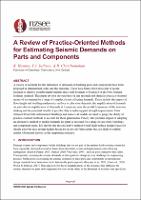| dc.contributor.author | Haymes, Kieran | |
| dc.contributor.author | Sullivan, Tim | |
| dc.contributor.author | Chandramohan, Reagan | |
| dc.date.accessioned | 2023-08-28T04:23:28Z | |
| dc.date.available | 2023-08-28T04:23:28Z | |
| dc.date.issued | 2023-04-19 | |
| dc.identifier.uri | https://repo.nzsee.org.nz/xmlui/handle/nzsee/2590 | |
| dc.description.abstract | A variety of methods for the estimation of demands on building parts and components have been proposed in international codes and the literature. These have been reviewed as part of recent research co-funded by QuakeCoRE, RNC and the EQC, in an effort to identify possible improvements that could be made to Section 8 of the New Zealand loadings standard. This paper reviews the outcomes of this research and identifies practice-oriented means of accounting for a range of complex factors affecting demands. This includes consideration of the impact of floor height and building non-linearity on floor acceleration demands, the amplification of demands on parts due to resonant-type shaking and the potential benefit of part ductility in reducing part strength requirements. Results from both instrumented buildings and numerical models are used to gauge the ability of practice-oriented methods to account for these phenomena. Finally, the potential impact of adopting an alternative demand method for parts is assessed for a range of case study buildings and component types. It is shown that the alternative method would likely reduce design forces for ductile parts but may prompt higher design forces for any brittle parts that would likely be in resonance with the building shaking. | |
| dc.language.iso | en | |
| dc.publisher | New Zealand Society for Earthquake Engineering | |
| dc.relation.ispartofseries | 2023;67 | |
| dc.subject | Advancements in research and practice in seismic performance | |
| dc.title | A Review of Practice-Oriented Methods for Estimating Seismic Demands on Parts and Components | |
| dc.type | Article | |

